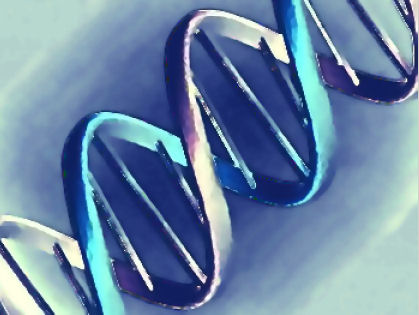Genetics
Genetics (from the Greek Genno γεννώ = give birth) is the science which studies the chemical functions specific to a particular species of molecules known as genes. One of its branches, the formal or Mendelian genetics, is concerned with the transmission of hereditary characteristics between parents and their offspring. This term encompasses a large number of disciplines, mostly related to biology.
History
The study of transmission of traits to the offspring was already practiced by farmers, and we consider that the various breeds of dogs (Canis familiaris) from successive selections of wolves (Canis lupus) since 20 000 years (it was shown that these two species are cross Canis). But since Aristotle up to and including Darwin (which with its "assumption of pangenese" proposes a theory), all believed in the natural transmission of acquired characters.
The interpretation from a unit that is the gene is more recent . Louis Pasteur, by proving the absence of spontaneous generation, sets a living creature has at least one ancestor from which it takes its characteristics.
The first serious study on the subject is performed by the monk Gregor Mendel, considered as a pioneer of genetics. By observing the transmission of the morphological characteristics of pea through a few generations, it defines the terms of phenotype and genotype and sets, giving a small boost to its figures, saying the laws of Mendel, the basis of modern genetics, and that pre-date the discovery of DNA. August Weismann in 1883 postulated the existence of a material of heredity. This theory then defended the impossibility of transmission of acquired characters (then defended by the neolamarckisme) and asked for a full adherence to Darwinism:
"The living beings derive from each other by small random variations continues sifted by natural selection. "

Hugo de Vries in Holland, Carl Correns and Erich von Tschermak in Germany rediscovered Mendel's laws in plants in 1901. In England, William Bateson became the most ardent defender of the laws of Mendel, in his book, published in 1902, "Gregor Mendel's principle of Heredity." Bateson was also the first to introduce in 1906 the term genetics. This discovery led to the idea that particulate material independent and juxtaposed (later called genes) passed, according to statistical laws unchanging from generation to generation. France was at that time, because of its tradition lamarck scientific and social, far from accepting such an idea. In 1902 however, the biologist, professor at the Faculty of Nancy,
Cuenot Lucien (1866-1951) found these laws in animals. Then he discovered in 1905, the first case of lethal gene in animals, the first phenomenon of epistasis (1907) where several genes located in different places of the chromosome involved in the same pathway and, in 1908, first case of pleiotropy when some genes can act on several seemingly independent characters. Between 1908 and 1912, he demonstrated the origin of certain hereditary cancers. In addition, since 1903, he proposed a possible interaction between mnemonic (gene), diastase (enzyme) and pigment (protein) which, in the french at the time, was a feat. United States, Thomas Hunt Morgan and his team developed in 1910 the chromosome theory of heredity, from Drosophila, easy fly breeding and reproduction is much faster than white mouse. He postulated exchange units chromosome during meiosis and developed a method that allows to locate the approximate position of genes on chromosomes.
Technical progress can gradually define the concept of gene. It was not until advances in microscopy to locate the genes support the chromosome. In the 1950s, a new step is taken by the American James Watson and Francis Crick determine the fine structure of the molecule constituting the genes, DNA, and thus help to understand the molecular mechanisms of heredity. A little later, three other Nobel, François Jacob, André Lwoff and Jacques Monod, show how it is structured in codons to program the synthesis of proteins from amino acid redundancy coding, the mechanism of mutations, and the presence of a code to stop playback, like on a tape. On this basis Jacob, Monod and Mayr in 1961 will advance the idea that the development and operation bodies are the product of a genetic program. This idea, popular among many biologists still has yet to date no scientific basis and has received no experimental confirmation.
Since then, genetic studies can gradually understand how genetic information is encoded in the chromosomes. It was also discovered that much of the DNA was non-coding.
More recently, we discovered a heredity based on mitochondrial DNA. This DNA is the cause of diseases transmitted exclusively by the mother. Indeed during fertilization, the paternal sperm mitochondria do not penetrate into the oocyte and the maternal mitochondria have (except in very rare exceptions) exclusively maternal in origin.
Genetics and Society
The beginnings of genetics have been troubled by two opposing trends. First, in Western countries, most geneticists adhered, at least initially, to eugenics. On the other hand, in the Soviet bloc, genetics was banned (and its supporters sent to the gulag) by which Stalin had placed his trust in Lyssenko.